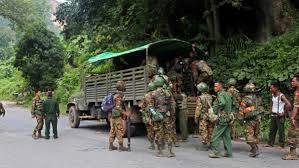ULFA claims 3 members killed in drone attack, Army denies

The banned militant group ULFA-I has claimed that three of its senior members died in a drone strike on their camps in Myanmar. The group blamed the Indian Army for the attack. However, the Army and the Assam government have denied any role in the incident.
This development has brought fresh focus to the tense Indo-Myanmar border, where insurgent groups often operate in remote areas.
What ULFA-I Claims
In a statement on Sunday, ULFA-I alleged that drones targeted their camps in Myanmar’s Sagaing region. The group said the strike happened between 2 am and 4 am. According to them, nearly 150 drones attacked the area in multiple waves.
The group named the deceased as:
- Lt. Gen. Nayan Medhi (alias Nayan Asom)
- Ganesh Asom
- Pradip Asom
ULFA-I said the first attack killed Nayan Medhi. While others were performing his funeral rites, more drones struck, killing Ganesh and Pradip. The group also reported that 19 others suffered injuries. They called the attack a “cowardly act” and promised to retaliate in the future.
Army and Government Response
The Indian Army firmly denied ULFA-I’s claim. A spokesperson said, “There are no inputs suggesting that such an operation took place.”
Assam Chief Minister Himanta Biswa Sarma also dismissed the report. “We have no knowledge of such action,” he said. Assam Police officials confirmed that no military operation had been planned from their territory.
Sources in the Ministry of Defence added that cross-border missions require top-level approval. They also said the Army did not carry out any such strike in recent days.
Confusion and Speculation
The contradictory claims have led to widespread speculation. Some security analysts believe Myanmar’s military or local rebel groups might have launched the attack. The Sagaing region has seen ongoing clashes between the Myanmar army and ethnic militias since the 2021 coup.
Others think ULFA-I may have fabricated or exaggerated the story. The goal might be to gain sympathy, recruit new members, or stir political reactions in Assam. A security expert from Guwahati said, “Insurgent groups often use such claims as psychological tools.”
About ULFA-I
ULFA-I is led by Paresh Baruah. The group wants an independent Assam and rejects peace talks with the Indian government. It operates from hideouts in the dense forests of Myanmar’s Sagaing and Kachin regions.
India and Myanmar have conducted several joint operations in the past. These include Operation Sunrise, which targeted multiple insurgent camps. But ULFA-I has remained active, using remote terrain as a shield.
If this drone strike really happened, it would mark a serious blow to the group. It would also signal a shift in anti-insurgency tactics.
Drone Warfare in the Region
India has increased its use of drones in recent years. These include Heron drones from Israel and new loitering munitions. The military mainly uses them for surveillance and surgical strikes within Indian borders.
Launching drones into foreign territory like Myanmar is a complex issue. It involves diplomatic risks and international legal concerns. That’s why experts are skeptical about India’s direct role in this event.
One possibility is that Myanmar forces or rival ethnic groups used drones to attack ULFA-I camps. The region’s ongoing civil unrest has seen a rise in drone warfare.
What It Means for the Northeast
Even if India was not involved, the incident raises concerns for Northeast India’s security. States like Nagaland, Arunachal Pradesh, and Manipur share borders with Myanmar and have long faced insurgent threats.
India’s government has signed peace deals with several groups in recent years. However, ULFA-I continues its militant operations, especially in Upper Assam. This event could push the group to increase its attacks or provoke unrest.
The timing also matters. India is trying to improve ties with Southeast Asia through its Act East policy. Violence along the border could derail trade and infrastructure projects in the region.
What’s Next?
No independent agency has confirmed ULFA-I’s claims yet. There are no satellite images or third-party reports proving the drone strike. Until more evidence appears, the truth remains unclear.
If confirmed, the strike could reshape regional conflict dynamics. If not, it may expose a propaganda effort by ULFA-I to revive its fading relevance.
Either way, this episode highlights the fragile balance of peace and violence along India’s eastern frontier.






